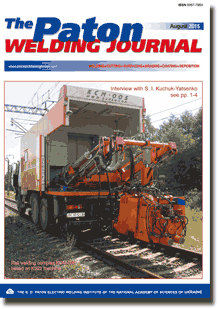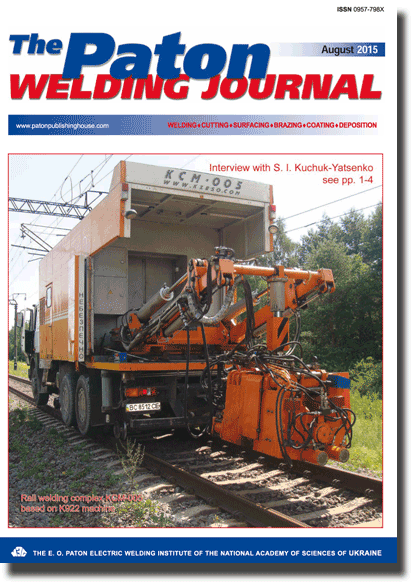| 2015 №08 (04) |
DOI of Article 10.15407/tpwj2015.08.05 |
2015 №08 (06) |

The Paton Welding Journal, 2015, #8, 26-30 pages
Analysis of the copper-chromium based electrode deformation during resistance spot welding process
C. Nachimani
Department of Mechanical Engineering, Faculty of Engineering, University of Malaya. 50603, Kuala Lumpur, Malaysia. E-mail: nachicharde@yahoo.com
Abstract
This research presents an experimental investigation of the RMWA class two (Cu-Cr) electrode caps in resistance spot welding of carbon and stainless steels. A pair of equal-size circled-electrode caps 5 mm diameter is committed to weld up to 900 welding processes. The electrode caps are sharpened once in the meantime and are replaced using electrode dresser after underwent approximately 400 weld attempts. The degrading factors of Cu-Cr electrodes have directly influenced the weld geometries on carbon and stainless steels while affected the bonding strength implicitly. The electrode caps that performed up to 900 weld attempts have been underwent the microstructural analytical observation, and several cracks in its internal structure were found. The internal cracks are only appeared in the movable-upper electrode cap due to continuous heating and hitting effects by pneumatic pressures, to compared with static-lower electrode in the 75kVрA spot welder. Mushroom growth of electrode cap tips is another threat to weld surfaces as it reduces the process resistances during welding. In this experiment, the mushroom growth is seemed to be higher on upper side electrode than the lower side one. With increased diameter of electrode tip areas due to mushrooming effect, the weld geometries become odds which lead to inconsistency in its appearances and pave the way for expulsions. 21 Ref., 9 Figures.
Keywords: spot welding, electrode mushroom, electrode degrading, electrode deterioration
Received: 27.04.15
Published: 13.10.15
References
- Bower, R.J., Sorensen, C.D., Eager, T.W. (1990) Electrode geometry in resistance spot welding. Welding J., 2, 45-51.
- Babu, S.S., Santella, M.L., Peterson, W (2000) Modelling resistance spot welding electrode life. ORNL.
- Yeung, K.S., Thornton, P.H. (1999) Transient thermal analysis of spot welding electrodes. Welding J., 1-6.
- Chakrabarti, D.J., Laughlin, D.E. (1984) The chromium-copper (Cu-Cr) system. Bull. of Alloy Phase Diagrams, 5(1).
- Chen, Z., Zhou, Y., Scotchmer, N. (2005) Coatings on resistance welding electrodes to extend life. SAE Int., 1-4.
- Nachimani, C. (2012) Effect of spot welding variables on nugget size and bond strength of 304 austenitic stainless steel (2 mm). Australasian Welding J., 57, 39-44.
- Nachimani, C., Farazila, Y., Rajprasad, R. (2014) Material characterizations of mild steels, stainless steels, and both steel mixed joints under resistance spot welding (2-mm sheets). Int. J. Advanced Manufact. Techn., 75(1-4), 373. https://doi.org/10.1007/s00170-014-6158-z
- Rao, Z.H., Liao, S.M., Tsai, H.L. et al. (2009) Mathematical modeling of electrode cooling in resistance spot welding. Welding J., 111-119.
- Elise, G., Denis, C., Philippe, R. et al. (2014) Numerical modelling of electrode degradation during resistance spot welding using CuCrZr electrodes. J. Materials Eng. and Perform., 23(5), 1593-1599. https://doi.org/10.1007/s11665-014-0908-9
- Chang, B.H., Zhou, Y. (2003) Numerical study on the effect of electrode force in small scale resistance spot welding. J. Materials Proc. Techn., 139, 635-641. https://doi.org/10.1016/S0924-0136(03)00613-7
- Babu, S.S., Joseph, A. (2010) Carpenter long-life electrodes for resistance spot welding of aluminum sheet alloys and coated high-strength steel sheet. Automotive Lightweighting Materials, 229-236.
- Luo, P., Dong, S., Xie, Z. et al. (2014) The effects of coating parameters on the quality of TiB-TiC composite phase coating on the surface of Cu-Cr-Zr alloy electrode. Surface and Coatings Techn., 253, 132-138. https://doi.org/10.1016/j.surfcoat.2014.05.025
- Li, Y.B., Wei, Z.Y., Li, Y.T. et al. (2013) Effects of cone angle of truncated electrode on heat and mass transfer in resistance spot welding. Int. J. Heat and Mass Transfer, 65, 400-408. https://doi.org/10.1016/j.ijheatmasstransfer.2013.06.012
- Bayraktar, E., Moiron, J., Kaplan, D. (2006) Effect of welding conditions on the formability characteristics of thin sheet steels: Mechanical and metallurgical effects. J. Materials Proc. Techn., 175, 20-26. https://doi.org/10.1016/j.jmatprotec.2005.04.007
- Primoz Podrzaj, Samo Simoncic (2014) A machine vision-based electrode displacement measurement. Welding in the World, 58, 93-99. https://doi.org/10.1007/s40194-013-0086-7
- Wei, P.S., Wu, T.H. (2014) Effects of electrode contact condition on electrical dynamic resistance during resistance spot welding. Sci. and Techn. of Welding and Joining, 19(2), 173-180. https://doi.org/10.1179/1362171813Y.0000000177
- Wei, P.-Sh., Wu, T.-H., Chen, L.-J. (2013) Joint quality affected by electrode contact condition during resistance spot welding. IEEE Transact. on Components, Packaging and Manufact. Techn., 3(12), 2164-2173. https://doi.org/10.1109/TCPMT.2013.2284497
- Aravinthan, A., Nachimani, C. (2011) Analysis of spot weld growth on mild and stainless steel (1 mm). Welding J., Aug., 143-147.
- Pouranvari, M., Marashib, S.P.H. (2010) Failure mode transition in AHSS resistance spot welds. Pt1: Controlling factors. Materials Sci. and Eng. A, 528, 8337-8343. https://doi.org/10.1016/j.msea.2011.08.017
- Feramuz, K. (2009) The effect of process parameter on the properties of spot welded cold deformed AISI 304 grade austenitic stainless steel. J. Materials Proc. Techn., 209, 4011-4019. https://doi.org/10.1016/j.jmatprotec.2008.09.030
- Dursun, O. (2008) An effect of weld current and weld atmosphere on the resistance spot weld ability of 304L austenitic stainless steel. Materials and Design, 29, 597-603. https://doi.org/10.1016/j.matdes.2007.03.008
Suggested Citation
C. Nachimani (2015) Analysis of the copper-chromium based electrode deformation during resistance spot welding process. The Paton Welding J., 08, 26-30.The cost of subscription/purchase order journals or individual articles
| Journal/Currency | Annual Set | 1 issue printed |
1 issue |
one article |
| TPWJ/USD | 384 $ | 32 $ | 26 $ | 13 $ |
| TPWJ/EUR | 348 € | 29 € | 24 € | 12 € |
| TPWJ/UAH | 7200 UAH | 600 UAH | 600 UAH | 280 UAH |
| AS/UAH | 1800 UAH | 300 UAH | 300 UAH | 150 UAH |
| AS/USD | 192 $ | 32 $ | 26 $ | 13 $ |
| AS/EUR | 180 € | 30 € | 25 € | 12 € |
| SEM/UAH | 1200 UAH | 300 UAH | 300 UAH | 150 UAH |
| SEM/USD | 128 $ | 32 $ | 26 $ | 13 $ |
| SEM/EUR | 120 € | 30 € | 25 € | 12 € |
| TDNK/UAH | 1200 UAH | 300 UAH | 300 UAH | 150 UAH |
| TDNK/USD | 128 $ | 32 $ | 26 $ | 13 $ |
| TDNK/EUR | 120 € | 30 € | 25 € | 15 € |
AS = «Automatic Welding» - 6 issues per year;
TPWJ = «PATON WELDING JOURNAL» - 12 issues per year;
SEM = «Electrometallurgy Today» - 4 issues per year;
TDNK = «Technical Diagnostics and Non-Destructive Testing» - 4 issues per year.


